Galata Tower
The Galata Tower (Turkish: Galata Kulesi), called Christea Turris (the "Tower of Christ" in Latin) by the Genoese, is a medieval stone tower in the Galata/Karaköy quarter of Istanbul, Turkey, just to the north of the Golden Horn's junction with the Bosphorus. It is a high, cone-capped cylinder that dominates the skyline and offers a panoramic vista of Istanbul's historic peninsula and its environs.
| The Galata Tower | |
|---|---|
Galata Kulesi | |
 View from Bosphorus | |
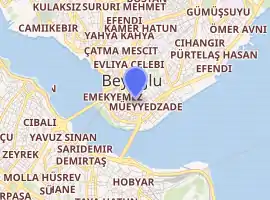
| |
| General information | |
| Type | Observation tower Broadcasting tower |
| Location | Istanbul, Turkey |
| Coordinates | 41°1′32.36″N 28°58′26.96″E |
| Completed | 1348 |
| Owner | City of Istanbul, Turkey |
| Management | Galata Kulesi, İstanbul Büyükşehir Belediyesi BELTUR |
| Height | |
| Architectural | 67 m (220 ft)[1] |
| Tip | 63 m (207 ft)[1] |
| Top floor | 52 m (171 ft)[1] |
| Technical details | |
| Floor count | 9[2] |
| Lifts/elevators | 2[2] |
| Website | |
| Galata Tower | |
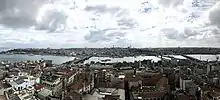
Description
The nine-story tower is (62.59 m (205.3 ft) without the ornament on top, 51.65 m (169.5 ft) at the observation deck), and was the city's tallest structure when it was built. The elevation at ground level is 61 m (200 ft) above sea-level. The tower has an external diameter of 16.45 m (54.0 ft) at the base, an inside diameter of 8.95 m (29.4 ft), and walls that are 3.75 m (12.3 ft) thick.
There is a restaurant and café on its upper floors which have views of Istanbul and the Bosphorus. Also located on the upper floors is a nightclub which hosts a Turkish show. There are two operating elevators that carry visitors from the lower level to the upper levels.
History
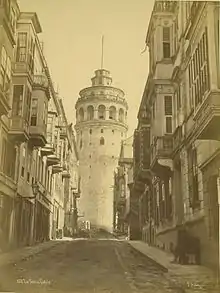
The Romanesque style tower was built as Christea Turris ("Tower of Christ") in 1348 during an expansion of the Genoese colony in Constantinople. Galata Tower was the tallest building in Istanbul at 219.5 ft (66.9 m) when it was built in 1348.[3] It was built to replace the old Tower of Galata, an original Byzantine tower named Megalos Pyrgos ("Great Tower") which controlled the northern end of the massive sea chain that closed the entrance to the Golden Horn. That tower was on a different site and was largely destroyed in 1203, during the Fourth Crusade of 1202–1204.[4]
The upper section of the tower with the conical cap was slightly modified in several restorations during the Ottoman period when it was used as an observation tower for spotting fires.
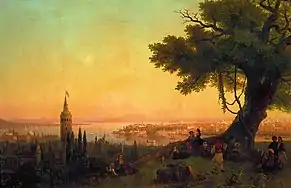
Starting from 1717, the Ottomans began to use the tower for spotting fires in the city. In 1794, during the reign of Sultan Selim III, the roof of the tower was made of lead and wood, and the stairs were severely damaged by a fire. Another fire damaged the building in 1831, upon which a new restoration work took place.
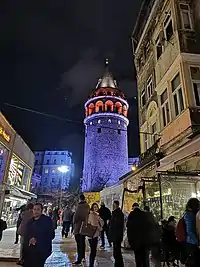
In 1875, during a storm, the conical roof on the top of the building was destroyed.[5][6] The tower remained without this conical roof for the rest of the Ottoman period. Many years later, during the restoration works between 1965 and 1967, the conical roof was reconstructed.[5][6] During this final restoration in the 1960s, the wooden interior of the tower was replaced by a concrete structure and it was commercialized and opened to the public.
From the top of the tower, the first French panorama painter, Pierre Prévost, drew his "Panorama de Constantinople" in 1818, which was later exhibited in Paris in 1825.[7] The panorama image shown below is composed of ten photos[8] taken from the Galata Tower by the photographic firm of Sébah & Joaillier, and is likely to have been taken in the 1880s.
See also
| Wikimedia Commons has media related to Galata Tower. |
References and notes
- "Eiffel Tower". CTBUH Skyscraper Center.
- Galata Tower at Emporis
- Katie Hallam (2009). The Traveler's Atlas: Europe. London: Barron's Educational Series.(2009), p. 118-119.
- Kazhdan, Alexander, ed. (1991), Oxford Dictionary of Byzantium, Oxford University Press, p. 815, ISBN 978-0-19-504652-6
- "Time Out Istanbul: "Galata Kulesi'nin eski fotoğraflarda neden farklı göründüğünü merak ettiniz mi?"". Archived from the original on 11 February 2014. Retrieved 8 June 2014.
- Galatakulesi.org: "Galata Kulesi: Kısa Tarihçe" Archived 2014-07-15 at the Wayback Machine
- Louis du Chalard & Antoine Gautier, "Les panoramas orientaux du peintre Pierre Prévost (1764-1823)", in Orients, Bulletin de l'association des anciens élèves et amis des langues orientales, juin 2010, p.85-108.
- Panorama of Constantinople, Taken from the Galata Tower World Digital Library. Library of Congress. Retrieved 3 December 2010.
